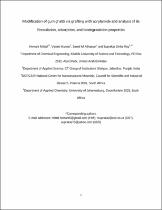 ResearchSpace
ResearchSpace
Modification of gum ghatti via grafting with acrylamide and analysis of its flocculation, adsorption, and biodegradation properties
JavaScript is disabled for your browser. Some features of this site may not work without it.
- ResearchSpace
- →
- Research Publications/Outputs
- →
- Journal Articles
- →
- View Item
| dc.contributor.author |
Mittal, H

|
|
| dc.contributor.author |
Kumar, V

|
|
| dc.contributor.author |
Alhassan, SM

|
|
| dc.contributor.author |
Ray, Suprakas S

|
|
| dc.date.accessioned | 2018-11-30T06:45:30Z | |
| dc.date.available | 2018-11-30T06:45:30Z | |
| dc.date.issued | 2018-07 | |
| dc.identifier.citation | Mittal, H., Kumar, V., Alhassan, S.M. and Ray, S.S. 2018. Modification of gum ghatti via grafting with acrylamide and analysis of its flocculation, adsorption, and biodegradation properties. International Journal of Biological Macromolecules, vol 114, pp 283-294 | en_US |
| dc.identifier.issn | 0141-8130 | |
| dc.identifier.issn | 1879-0003 | |
| dc.identifier.uri | https://www.ncbi.nlm.nih.gov/pubmed/29580994 | |
| dc.identifier.uri | http://hdl.handle.net/10204/10566 | |
| dc.description | Copyright: 2018 Elsevier Science. Due to copyright restrictions, the attached PDF file only contains the abstract of the full-text item. For access to the full-text item, please consult the publisher's website. The definitive version of the work is published in International Journal of Biological Macromolecules, vol 114, pp 283-294 | en_US |
| dc.description.abstract | In this work, an environmentally friendly gum ghatti-crosslinked-polyacrylamide (Gg-cl-PAAM) hydrogel was synthesized from gum ghatti (Gg) and acrylamide (AAM) using a microwave-assisted grafting technique, and tested for use in water purification applications as an adsorbent and flocculent. The Gg-cl-PAAM was characterized using SEM, FTIR, and TGA, and displayed pH responsive swelling behavior, with maximum swelling (2117%) observed in solution with neutral pH. The flocculation characteristics of Gg-cl-PAAM were tested in clay solutions as a function of pH, temperature, and the polymer mass loading, showing that the best performance is obtained at neutral pH at 40°C. The adsorption capacities of Gg-cl-PAAM for the removal different dyes such as brilliant green (BG), rhodamine B (RhB), congo red (CR), and methyl orange (MO) were tested, revealing that the adsorption of all dyes followed the Langmuir isotherm model, with q(subm) values of 523.62mgg(sup-1) for BG, 421.60mgg(sup-1) for RhB, 179.09mgg(sup-1) for CR, and 173.69mgg(sup-1) for MO. Finally, the environmentally friendly nature of Gg-cl-PAAM was examined using the soil-burial composting method, which demonstrated 93% degradation of the Gg-cl-PAAM hydrogel within 60days. | en_US |
| dc.language.iso | en | en_US |
| dc.publisher | Elsevier Science | en_US |
| dc.relation.ispartofseries | Workflow;21477 | |
| dc.subject | Adsorption | en_US |
| dc.subject | Biodegradable hydrogel | en_US |
| dc.subject | Dye removal | en_US |
| dc.subject | Flocculation | en_US |
| dc.title | Modification of gum ghatti via grafting with acrylamide and analysis of its flocculation, adsorption, and biodegradation properties | en_US |
| dc.type | Article | en_US |
| dc.identifier.apacitation | Mittal, H., Kumar, V., Alhassan, S., & Ray, S. S. (2018). Modification of gum ghatti via grafting with acrylamide and analysis of its flocculation, adsorption, and biodegradation properties. http://hdl.handle.net/10204/10566 | en_ZA |
| dc.identifier.chicagocitation | Mittal, H, V Kumar, SM Alhassan, and Suprakas S Ray "Modification of gum ghatti via grafting with acrylamide and analysis of its flocculation, adsorption, and biodegradation properties." (2018) http://hdl.handle.net/10204/10566 | en_ZA |
| dc.identifier.vancouvercitation | Mittal H, Kumar V, Alhassan S, Ray SS. Modification of gum ghatti via grafting with acrylamide and analysis of its flocculation, adsorption, and biodegradation properties. 2018; http://hdl.handle.net/10204/10566. | en_ZA |
| dc.identifier.ris | TY - Article AU - Mittal, H AU - Kumar, V AU - Alhassan, SM AU - Ray, Suprakas S AB - In this work, an environmentally friendly gum ghatti-crosslinked-polyacrylamide (Gg-cl-PAAM) hydrogel was synthesized from gum ghatti (Gg) and acrylamide (AAM) using a microwave-assisted grafting technique, and tested for use in water purification applications as an adsorbent and flocculent. The Gg-cl-PAAM was characterized using SEM, FTIR, and TGA, and displayed pH responsive swelling behavior, with maximum swelling (2117%) observed in solution with neutral pH. The flocculation characteristics of Gg-cl-PAAM were tested in clay solutions as a function of pH, temperature, and the polymer mass loading, showing that the best performance is obtained at neutral pH at 40°C. The adsorption capacities of Gg-cl-PAAM for the removal different dyes such as brilliant green (BG), rhodamine B (RhB), congo red (CR), and methyl orange (MO) were tested, revealing that the adsorption of all dyes followed the Langmuir isotherm model, with q(subm) values of 523.62mgg(sup-1) for BG, 421.60mgg(sup-1) for RhB, 179.09mgg(sup-1) for CR, and 173.69mgg(sup-1) for MO. Finally, the environmentally friendly nature of Gg-cl-PAAM was examined using the soil-burial composting method, which demonstrated 93% degradation of the Gg-cl-PAAM hydrogel within 60days. DA - 2018-07 DB - ResearchSpace DP - CSIR KW - Adsorption KW - Biodegradable hydrogel KW - Dye removal KW - Flocculation LK - https://researchspace.csir.co.za PY - 2018 SM - 0141-8130 SM - 1879-0003 T1 - Modification of gum ghatti via grafting with acrylamide and analysis of its flocculation, adsorption, and biodegradation properties TI - Modification of gum ghatti via grafting with acrylamide and analysis of its flocculation, adsorption, and biodegradation properties UR - http://hdl.handle.net/10204/10566 ER - | en_ZA |





